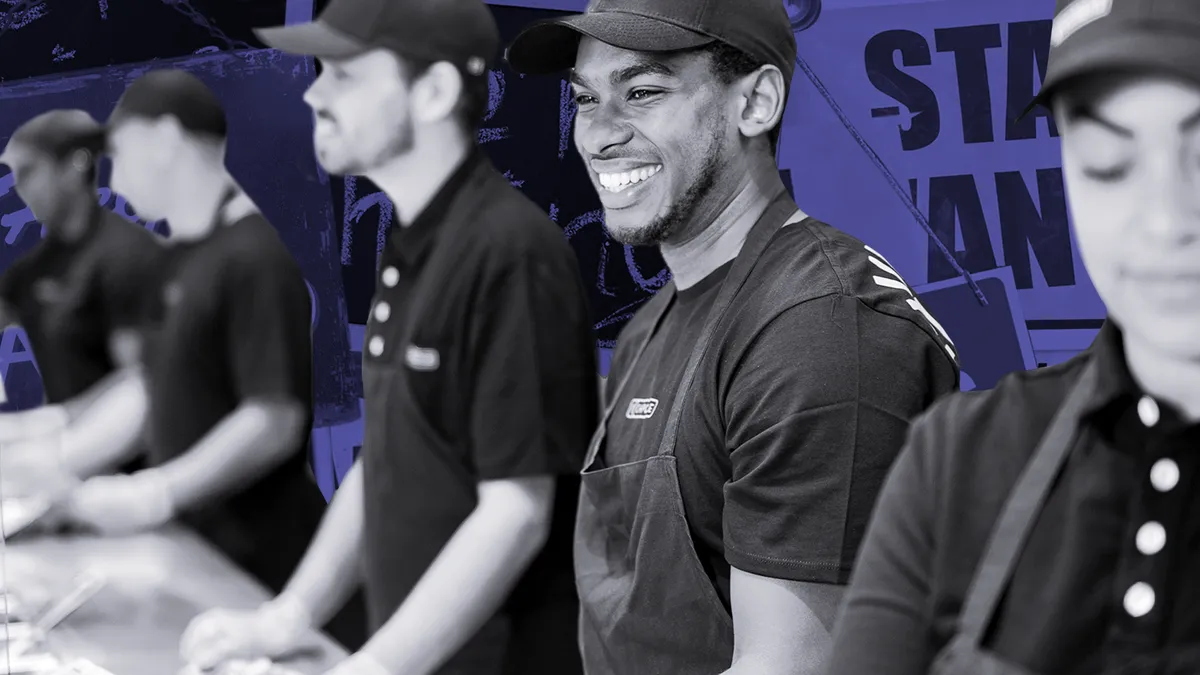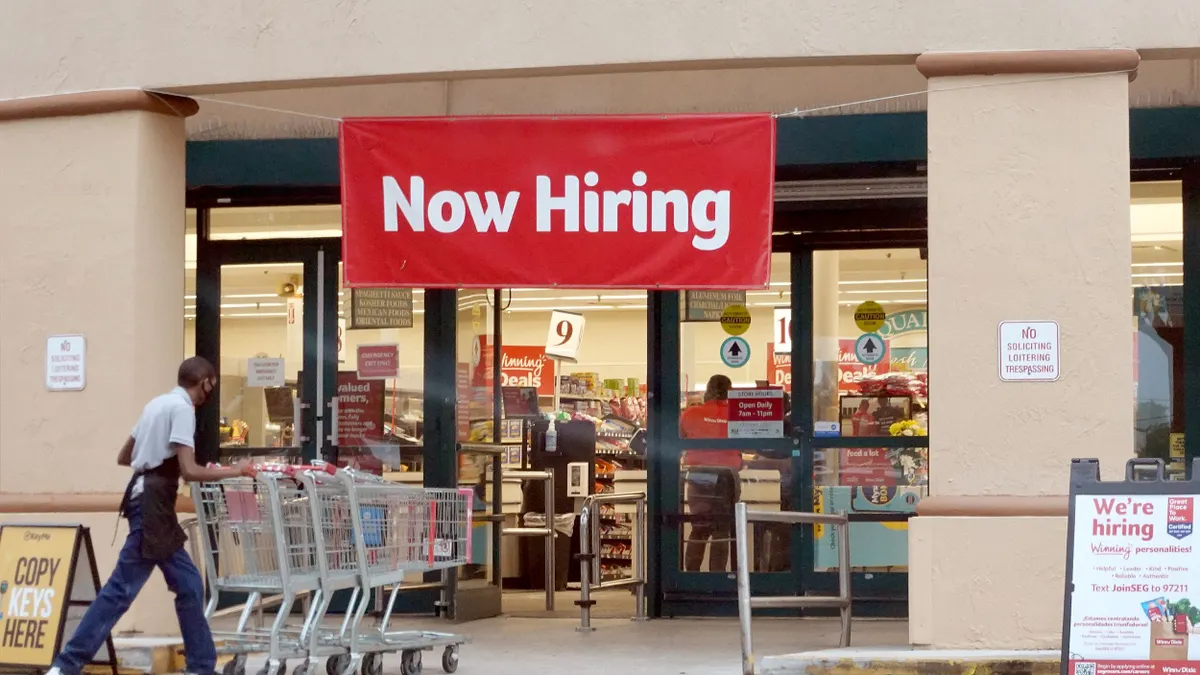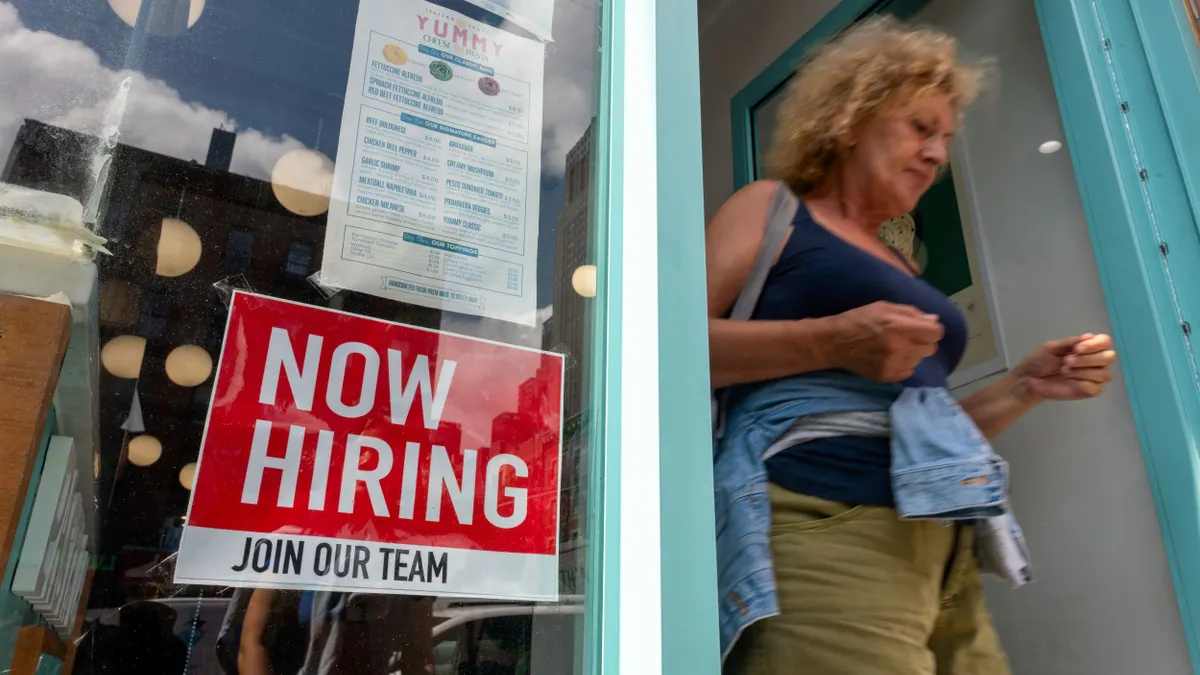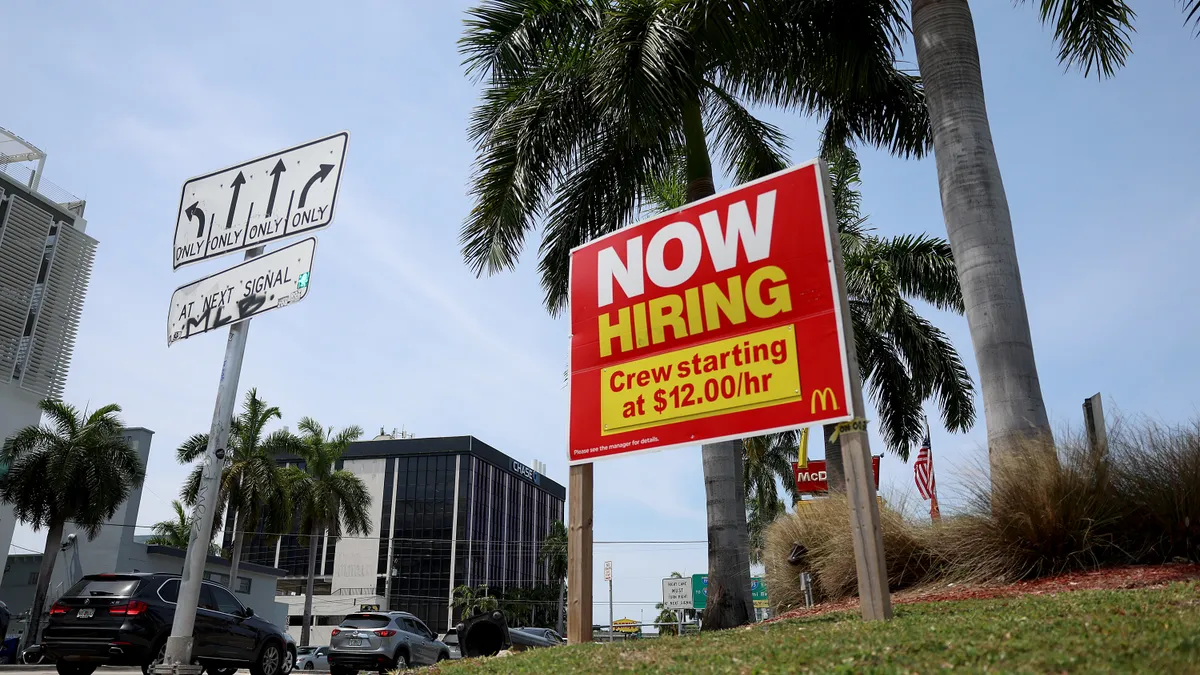This piece originally appeared in a three-part series about the restaurant labor shortage published by HR Dive sister publication Restaurant Dive.
When Delaware Gov. John Carney initially shut down restaurant dining in March 2020, Heirloom Restaurant owner Meghan Lee called her dad to figure out what to do. She had over a dozen people on salary, many had been with her for two to five years ago, when the restaurant opened. During her conversation with her father, she realized she'd have to lay everyone off so they could go on unemployment.
"I literally was like, 'I'm going to throw up.' Some of [my staff] have children. It just sent me into a panic," Lee said.
In addition to making sure unemployment was filed quickly on her end, Lee gave her staff food from her pantry and raised $40,000 through a GoFundMe campaign, which she distributed equally among her employees. Since she knew the restaurant would eventually be allowed to reopen, she created odd jobs for her workers in the meantime, such as power washing the patio, and paid them in cash.
Her efforts have paid off. During a time when many independent and chain restaurants are struggling to rehire and attract new employees, Lee has retained her team. Many restaurants are also experimenting with tactics to make sure their culture is welcoming for workers, boosting benefits and developing cross-training to build up workers' skills.
Experts say retention is one of the best cost-saving labor strategies, as well.
"It's the self-defeating loop as the main reason that companies should look at this. If you don't focus on retention, you're always going to be focusing on attraction and hiring," Dan Sines, Traitify CEO, said. Traitify works predominantly with high-volume restaurants, retail and hospitality companies to help with hiring.
For national QSRs with 100% to 200% turnover rates, this could be a $20 million to $40 million problem, which could substantially impact bottom lines, Sines said.
"If you can refocus your efforts, making sure you're providing a better work environment for these people, paying these people more, keeping them excited about the positions that they're in, and showing them upward mobility, that cost goes way down," Sines said. "And it becomes something that, I think, is a real ROI generator for the business."
Improving training, staff communication
Once employees are brought onto the job, proper training is key to retention, especially when it comes to career progression. Cross-training is becoming more common in QSRs, where it is easier for employees to swap roles because most employees tend to work behind the counter either in the kitchen or at the cash registers, Vivian Wang, Landed CEO, said. Landed is a mobile app that helps match hourly food and retail employees with employers.
Front-of-house staff are trained in back-of-house so they can be deployed in either role, Wang said. This tactic can also help employees gain the skills they need to move up. For example, positions like kitchen management still have a heavy emphasis on customer service, and those skills can be learned by interacting with customers at the cash register.
"We're seeing those employers [offering cross-training] are more successful in employee happiness and lower attrition," Wang said.
Lee uses this strategy at Heirloom, where her sous chef can run food out to customers while food runners can make cheese boards, for example.
"Anytime anybody new comes into the building, they are completely 100% cross-utilized," Lee said. "If you are running a tight ship and a small staff, everybody knows how to do everything."
Another way to decrease turnover is by improving the manager-employee relationship, Sines said. Traitify launched a tool during the pandemic called Engage that is designed to help solve this issue. It offers 90 days worth of development tips based on an employee's personality and ways to better interact with their co-workers and managers, Sines said. The idea behind this tool was to help with voluntary turnover, especially in QSRs, he said.
It also helps provide managers with more perspectives on how employees see things, and vice versa, helping teams find ways to get on the same page, Sines said.
"We've been able to see that by really just taking that time to show you care, [employees] are far more likely to stay and stick around," Sines said.
"We're seeing those employers [offering cross-training] are more successful in employee happiness and lower attrition."

Vivian Wang
CEO, Landed
Traitify has helped the companies it works with reduce involuntary turnover by 30% by providing personality assessments that help employers match people into the best roles, which can help eliminate firing, Sines said. It's also seen an uptick in the amount of time workers are staying. Typically staff stay about three months at a restaurant, but are now staying about a year or longer after using tools like Engage, he said.
Landed has been working with its clients to help train them on ways to better manage staff. So instead of one general manager overseeing 120 employees at a single fast food restaurant, management would expand to include an assistant manager or a shift lead who can have closer relationships with and better manage hourly employees, Wang said.
Restaurants are also making it clear there is a chance for upward mobility for employees and that restaurant roles can be long-term jobs, Sines said.
Chipotle offers transparent career paths that include certified training at every level, and crew members sometimes become a manager of a restaurant within 18 months, Marissa Andrada, Chipotle's chief diversity, inclusion and people officer, said. Last year, the company promoted 13,000 employees in the organization and 70% of its general managers come from hourly workers. In May, the company announced it has created a path for hourly crew members to become restaurateurs, the highest general manager position, in as little as three and a half years.
"When we talk to our employees, [we ask] what is it they want to be able to grow and develop and be successful and productive human beings," Andrada said.
Once an employee starts at Pajco Inc., a convenience store and franchise operator of Midwest chain Imo's Pizza and Rally's, they learn about the company's growth trajectory during onboarding and training phases, Brett Anderson, vice president of operations and business development, said. This helps communicate that the company believes in its future, and isn't just putting on a facade to attract workers, he said.
In order to create a more consistent experience, the company brought on a director of people and culture earlier in 2021 to make sure that onboarding and training is not just telling a good story but an accurate story about the company, Anderson said.
"We certainly have our struggles, but I think ultimately, we have hired the [right people] for a very long time and it's paying some dividends for us, but it's still more difficult than it’s ever been," Anderson said.
Boosting benefits reduces turnover
Many chains and their franchisees are using same-day pay apps to offer an additional perk to employees and entice them to stay, while others like Chipotle and Starbucks are offering a number of educational and health benefits.
Tapcheck, an on-demand pay mobile app founded in 2019, integrates with existing payroll processing programs to gauge an employee's earnings as they go through the pay cycle and allow them to receive their pay when they want it, Co-Founder and CEO Ron Gaver said. Tapcheck works with chains like McDonald's, Burger King, Dunkin' and Little Caesars, as well as full-service restaurants.
Offering flexible pay schedules is making restaurants more competitive with the gig economy, which offers same-day or next-day pay as well, he said. It's also doubling the amount of applications a company receives and is helping reduce turnover by 48%. Employees are picking up more shifts and absenteeism is reducing by 78%, Gaver said.
Tapcheck offers financial education for employees in its app, including 1,000 articles and video courses that discuss topics like budgeting, saving for goals, spending less credit, creating an emergency fund, banking and credit cards, Gaver said.
Full-service chain Beef O' Brady's is doing a series of focus groups and surveys to make sure the company doesn’t miss any benefits or perks the employees find important. Frequency of pay is one area the restaurant is considering, CEO Chris Elliott said. Beef O' Brady's is looking into how weekly pay might benefit its workers. The company is also considering technology that would allow servers to get their tips sent to their bank accounts at the end of their shifts.
One of the most impactful benefits to Chipotle's retention has been its debt-free educational program, which it has offered since 2019 through a partnership with Guild, an education and upskilling company. Employees that have been with the company for four months and work 15 hours a week on average are eligible to participate, Andrada said. To date, Chipotle has seen a 3.5 times higher retention rate among students enrolled in the program, according to a press release. Crew members are also 7.5 times more likely to move into a management role if they use this benefit.
"This is a key benefit that is not only helpful for us in terms of developing leaders for the company, but leaders for life, whether they're here or they decide to go somewhere else," Andrada said.
The company also offers English as a second language and GED completion programs for all employees and families, Andrada said.
Chipotle started a quarterly bonus program in 2019, which gives eligible employees a week of extra pay each quarter if the store meets specified goals. During the first few months of the program, 2,600 employees qualified to earn the bonus, and the chain saw a reduction in employee turnover at the management and crew level. In August, the company offered nearly $6.5 million in discretionary bonuses to field leaders, apprentices and managers.
Additionally, Chipotle offers a healthcare concierge for all of its employees and families, regardless of whether they are enrolled for the company's healthcare benefits. That program helps employees access mental health counselors, including for telehealth appointments, for a nominal cost if the employee doesn't have insurance, Andrada said. For those with insurance, the concierge can also troubleshoot billing issues and help employees get a second opinion or appointment, among other services.
"When you take care of your people, they will take care of the experience and the experience will translate to growth in the business," Andrada said. "The only way you can run a successful restaurant — and we have 2,300 of them — is that they have to be fully staffed."
Why culture matters
For many restaurants, their most impactful retention strategy has been creating a positive company culture. At Beef O' Brady's, culture means employees are treated like valuable assets and not commodities, management has a strong rapport with their employees, orientation and training is done well, and employees are offered competitive wages and benefits, Elliott said.
"The culture in the store is key to minimizing turnover," Elliott said. "Minimizing turnover is the key to being able to stay properly staffed."
Culture begins with the interview process, how a job offer is made and what the first day is like, Elliott said. Did someone meet them on their first day to show them around? Did they get to meet the other staff members? Were they trained properly or do they have the proper experience in the job to effectively perform in their new role? Did they get good performance feedback? Is their pay competitive? Is there recognition and awards for good work? What's the environment of the restaurant? Is there good camaraderie? Is it a fun place to work?
"The reason why we're emphasizing the culture piece is that's really the piece that has to be in place to ultimately solve this challenge that our owners are facing," Elliott said.
Beef O' Brady's stores that are doing well have employees who have worked at these locations for over a decade, he said. One owner will make a birthday cake for each employee on their birthday, for example.
"People will tell you the culture at that store is second to none because the owners treat the employees like an extended family and they love working there," Elliott said. "And [the employees] have a lot of loyalty to the owners. They're not going to quit and go down the street for 50 cents more per hour."
Creating a family atmosphere has helped with retention at Pajco as well. The average tenure of its management teams is 17 years, Anderson said. With about half of its employees starting out as customers, that atmosphere starts with greeting people as they walk through the doors and thanking them when they leave, Anderson said.
"A lot of people talk about [how] there's nobody out there that wants to work. I'm here to tell you, they're out there. You just have to find them," Anderson said. "Are they willing to come into your four walls? Are you willing to recruit them by doing it the right way? Your company culture speaks for itself. The proof is in the pudding, so to speak."
Diamond Hospitality Enterprises — a multi-unit franchise operator that owns over 30 Hardee's restaurants in four states — decided during the height of the pandemic to not lay off any employees, owner Rob Schmidt said. The company, which employs about 800 people, shifted labor to focus on creating a great drive-thru service when dining rooms were closed, he said.
"If we had laid off 25% of our employees or had closed restaurants, we certainly would not be in a position like we are today where we're saying, 'Hey we're ready to grow, we need more. We want to add employees,'" Schmidt said.
"A lot of people talk about [how] there's nobody out there that wants to work. I'm here to tell you, they're out there. You just have to find them... Are you willing to recruit them by doing it the right way?"

Brett Anderson
VP of operations and business development, Pajco
Schmidt recounts a story from earlier this year when he sent his office manager out to visit all of the company's restaurants in Mississippi and Alabama. He told her to bring doughnuts, coffee and do something special. She was to go in and do nothing but give everyone a pat on the back, fists bumps and tell them they are doing a great job and are appreciated.
"It was one of the most impactful things we did," Schmidt said. "My restaurants had a high-level executive person who's not normally in the restaurants who went out of [her] way, took a bunch of time away from her family to go visit restaurants and just thank our people for being there for working hard, and doing the job that they're doing."
Employees later sent emails and text messages saying how much that meant to them, Schmidt said.
The company has such a positive perception within the local community that Schmidt is already receiving phone calls from prospective employees who heard about its partnership with Tropical Smoothie and its plans to open 16 locations, he said.
Heirloom's owner has also found success in creating a culture of respect with her staff, which have become an extended family, she said. Since the pandemic, Lee has found ways to help boost employee earnings and make sure they can get as many shifts as they can without cutting any other staff.
Lee, for instance, changed her approach to her front-of-house staff to boost individual earnings. Instead of bringing on five servers per shift, she brought on more support staff. Each shift would have three or four servers working alongside a busser and a runner, allowing the waitstaff to earn more in tips, Lee said. Instead of cutting staff when capacity was reduced by the governor, she reduced the number of shifts available per employee while offering them shifts if the restaurant was busy over the weekend.
"I've been really lucky that I've kept the same people, and I really take care of them," she said. "That's my goal and they know that. They are very loyal to me and I'm very loyal to them."























